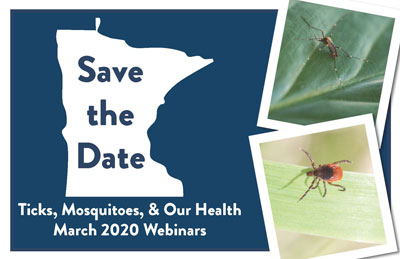
CAHFS and Minnesota Department of Health collaborate to make public health education more accessible
There are few things Minnesotans dread more than ticks and mosquitoes and, in recent years, the blood-thirsty bugs have increasingly become a public health threat. Between 2004 and 2016, the number of reported cases of vector-borne disease—which are spread through mosquito, tick, and flea bites—tripled in the United States, according to the U.S. Centers for Disease Control and Prevention. Diseases spread through tick bites alone doubled in the same timeframe.
A collaboration between the Minnesota Department of Health (MDH), the Board of Animal Health (BAH), and the University of Minnesota will make it easier for Minnesotans to learn about the latest trends in vector-borne diseases, and how those in the veterinary field can respond to the growing number of pathogen-harboring tick and mosquito bites in the state.
MDH will host a five-part webinar series every Tuesday in March, covering the impact Minnesota’s ticks and mosquitos have on human, environmental, and animal health. Each lunch hour training will be tailored to a particular audience, including tribal communities, outdoor enthusiasts, laboratorians, occupational workers, human healthcare workers, and homeowners.
For the series’ final installment on March 31, MDH collaborated the University of Minnesota’s Center for Animal Health and Food Safety (CAHFS) to convene experts from the College of Veterinary Medicine (CVM) to develop a curriculum geared towards the state’s veterinarians and veterinary technicians.
“Education is a big part of public health and trying to reach busy people is always a challenge,” says Jenna Bjork, DVM, MPH, senior epidemiologist with the Minnesota Department of Health Vectorborne Diseases Unit. “Offering a series of seminars that cover a similar topic, designing each for a different audience, and putting the series online creates better access to science-based, timely information.”
The webinar co-led by Janice Mladonicky, DVM, MPH, a current resident in CAHFS’s Veterinary Public Health and Preventive Medicine (VPHPM) residency program, will cover clinical signs and diagnostic techniques. Stacey Schwabenlander, DVM, MPH, DACVPM, from the BAH will explain reporting protocol for vector-borne diseases that impact animals, with a particular focus on Rocky Mountain spotted fever and tularemia, a disease carried by ticks and biting flies that must be reported to the Minnesota Board of Animal Health. In addition, CVM is offering one credit of continuing education to attending veterinarians and veterinary technicians who are licensed in Minnesota.
CAHFS and MDH will join forces again this summer to deliver training in the use of analytical tools to inform and support policy, taught by a team of veterinarians from Australia, New Zealand, Kuwait, Spain, and the United States. Developed in part by director of the VPHPM residency program, Michael Mahero, DVM, MPH, DACVPM, these in-person trainings and interdepartmental partnerships within the university allow animal-focused experts to develop a broader skill set.
“Consistent with the land grant mission of the University, partnerships with private and public entities such as the MDH are an important pathway for CAHFS to ensure scholarly material generated within the college is impacting lives across the state and the world,” says Mahero.
